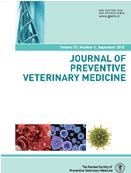학술논문
Guide for treatment of stomachs and intestines as edible meat co-products
이용수 0
- 영문명
- 발행기관
- 한국예방수의학회
- 저자명
- Young Ju Lee
- 간행물 정보
- 『Journal of Preventive Veterinary Medicine』Vol.39, No.2, 75~79쪽, 전체 5쪽
- 주제분류
- 의약학 > 기타의약학
- 파일형태
- 발행일자
- 2015.06.30

국문 초록
영문 초록
Edible meat co-products (ECoPs) have recently received significant attention, particularly those for human
consumption, because of the nutritional advantages of by-products and the worldwide emphasis on reducing economical loss by wasting. According to the regulations of the Animal and Plant Quarantine Agency in Korea, Korean edible by-products include more diverse internal organs than other nations, such as liver, lung, heart, stomach, pancreas, spleen, kidney, small intestine and colon, but there are no specific regulations for processing these by-products in Korea. Food borne pathogens such as salmonella, campylobacter and E.coli commonly reside in the gut flora of animals, including those that are clinically healthy. It is therefore very important that hygiene requirements are followed when stomachs and intestines are treated for human consumption, in order to prevent these pathogens passing into the human food chain. The requirements for these products have not always been well understood, and the guide attempts to explain these in a way that is helpful for operators.
목차
INTRODUCTION
TERMS AND SCOPE
WHY ARE HYGIENE REQUIREMENTS IMPORTANT IN THE PRODUCTION OF TREATED STOMACHS AND INTESTINES?
SEPARATION IN THE SLAUGHTERHOUSES
POST-MORTEM INSPECTION
HYGIENE IN THE SLAUGHTERHOUSES
CLEANING IN THE SLAUGHTERHOUSE
TEMPERATURE CONTROLS
IDENTIFICATION MARKING
TRACEABILITY
REFERENCES
해당간행물 수록 논문
참고문헌
최근 이용한 논문
교보eBook 첫 방문을 환영 합니다!

신규가입 혜택 지급이 완료 되었습니다.
바로 사용 가능한 교보e캐시 1,000원 (유효기간 7일)
지금 바로 교보eBook의 다양한 콘텐츠를 이용해 보세요!



